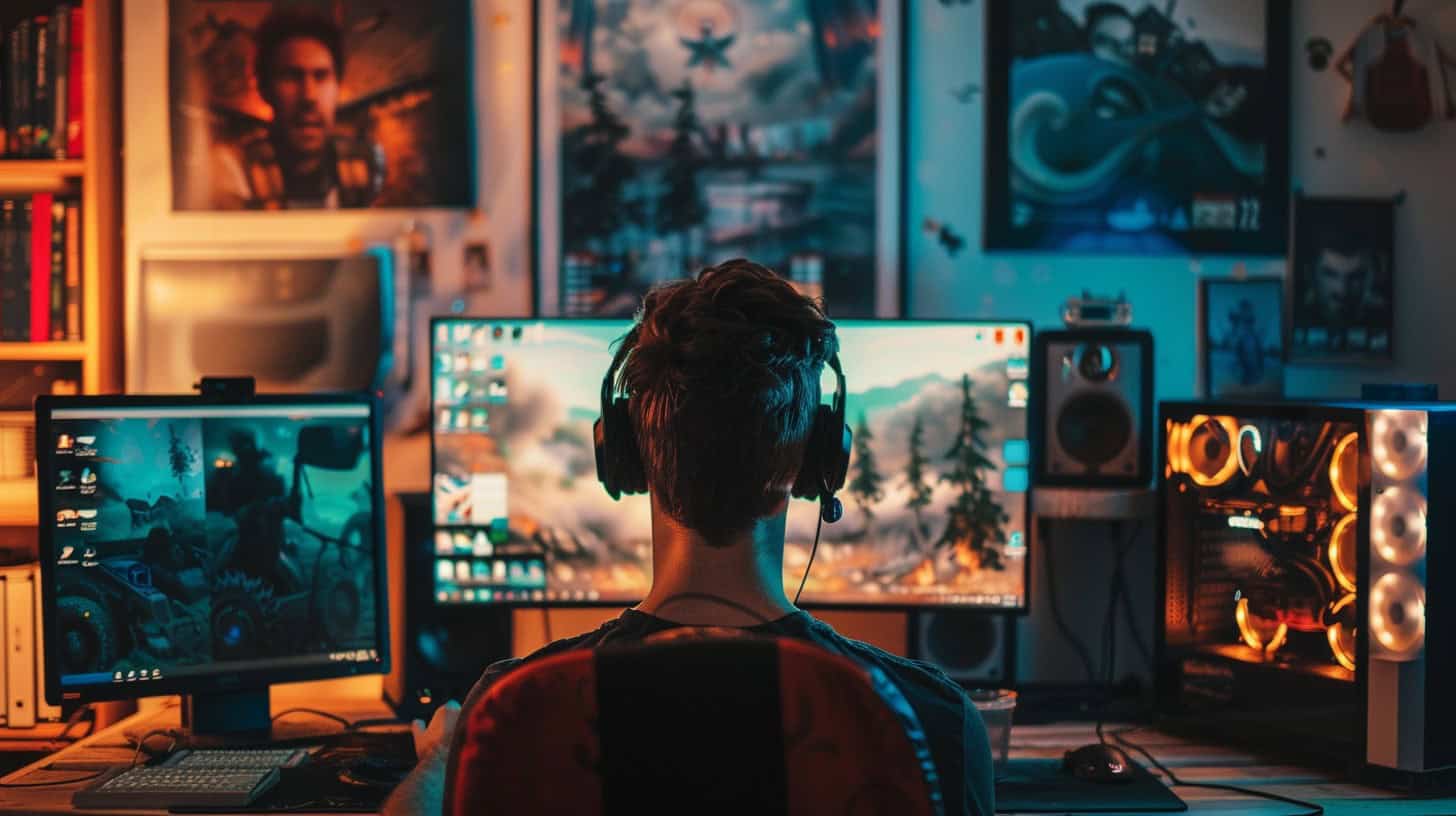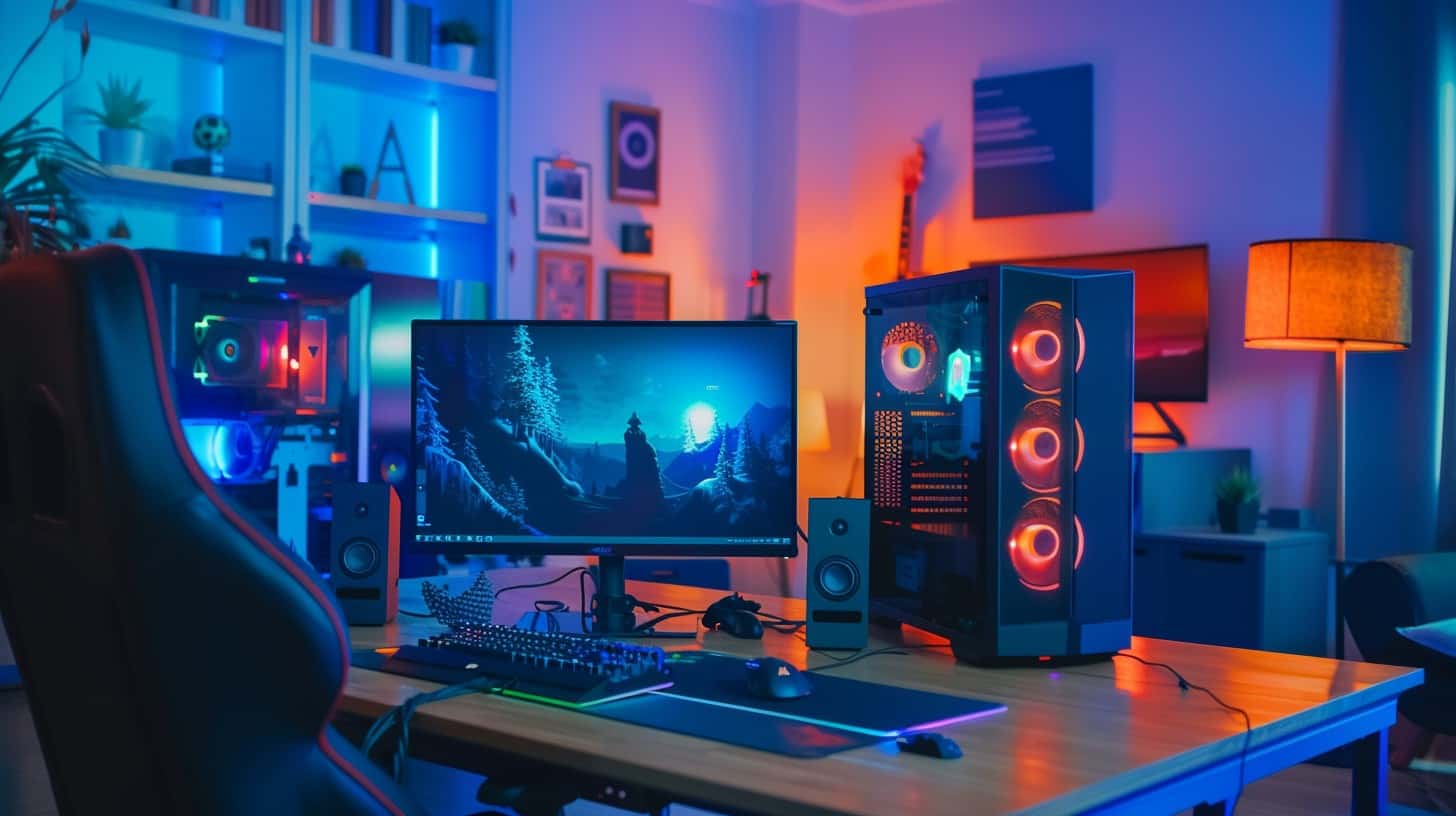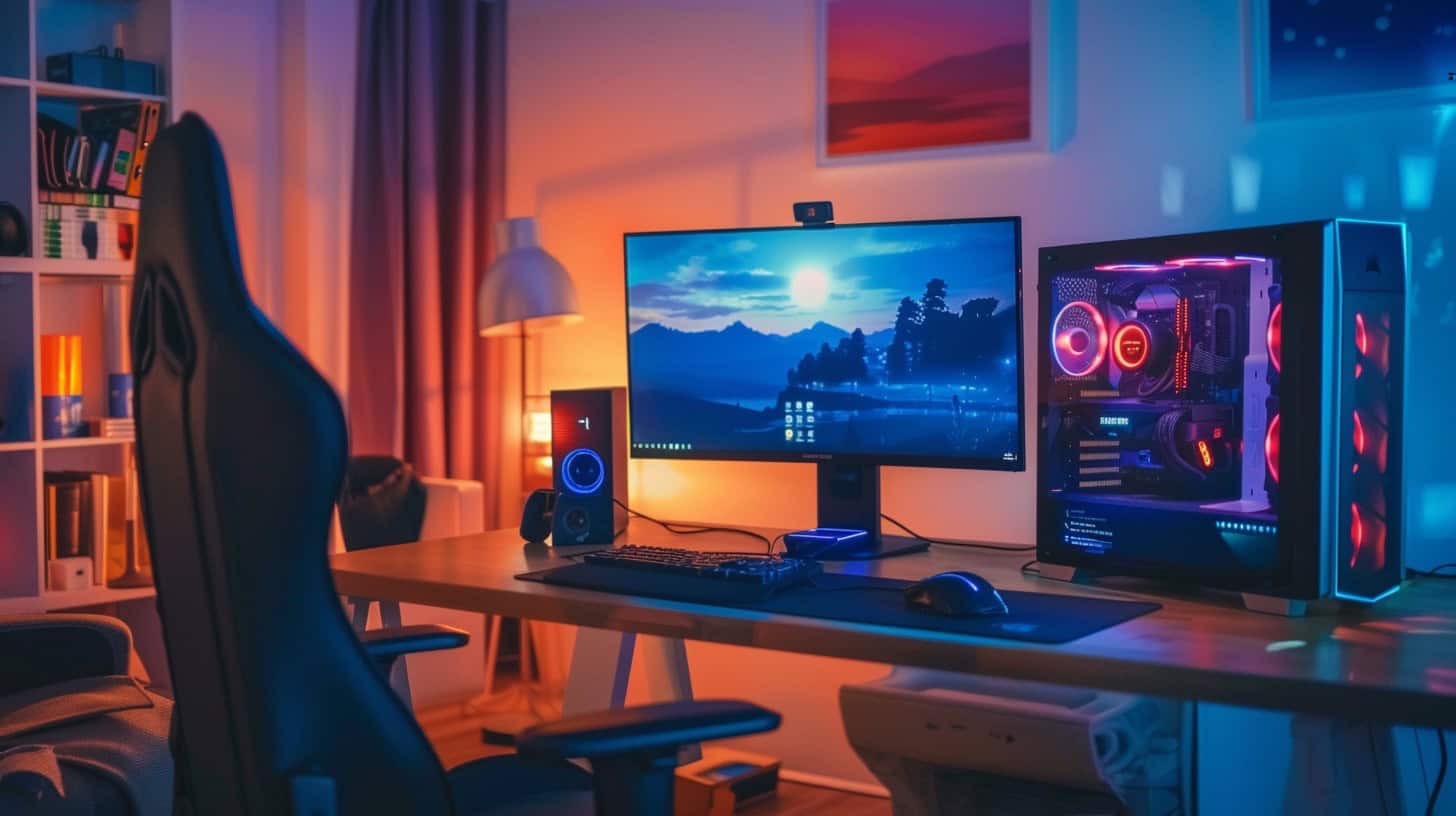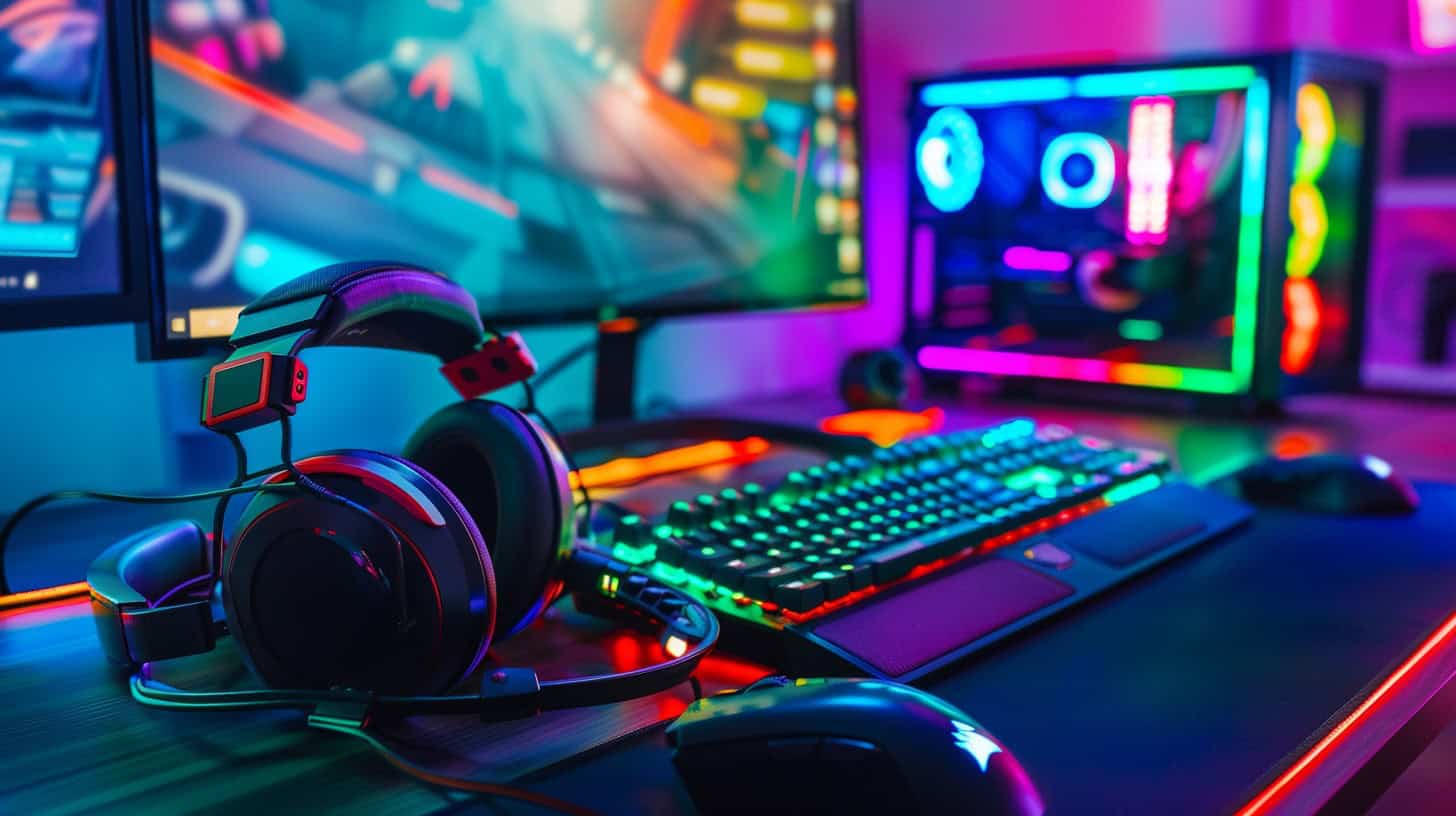Wondering how much cash you’ll need to enjoy gaming with a new PC in 2024? Here’s a fact: the price of a gaming computer swings from $850 to $2000 on average. This article throws light on ways to get your hands on one without breaking the bank.
Stay tuned for some wallet-friendly tips!
Key Takeaways
Gaming PCs in 2024 range from $850 to $2000 on average, but beginner setups can start as low as $400.
You can save money by building your own PC, looking for deals on parts, or buying second-hand options.
High-end gaming PCs cost more because they have powerful CPUs and graphics cards for the best performance.
Pre-built PCs are convenient and come with warranties, but may limit customization and upgrades.
Peripherals like monitors, keyboards, and mice add extra costs to your setup.
Table of Contents
Understanding the Cost of a Gaming PC

Peeking into the price tag on a gaming PC opens up a can of worms. From eye-catching graphics cards to speedy processors, each piece plays its part in the final cost.
Average Gaming PC Price
Stepping into the gaming world feels like a trip to a candy store. So many choices, right? Now, let’s talk cash for a sec. The average price for a gaming PC isn’t just a number. It’s your ticket to epic game nights and maybe a few bragging rights. Here’s a quick table to break it down:
| Type | Cost Range |
|---|---|
| Average Gaming PC | $850 to $2000 |
That table is like a map. It shows where we’re headed, money-wise. Now, my wallet cried a bit when I first saved up for mine. I had to do some odd jobs, save change from couch cushions, you name it. But boy, was it worth it. Every cent. My rig now is not just a machine. It’s my companion on late-night raids and endless quests.
Saving tips? I’ve got them. First off, aim for the lower end if money’s tight. You’d be surprised how many cool games you can still play. Keep an eye out for deals, too. Sometimes, parts go on sale, and that’s your golden ticket.
Building versus buying? Both have their perks. Building gets you more bang for your buck, but it’s like piecing together a complex LEGO set. Buying pre-built is easy mode—plug and play. Yet, it might cost a bit more.
Here’s the deal—don’t let the price tag scare you. Think of it as investing in a hobby that pays back in fun and maybe some new friends. Plus, nothing beats the feeling of powering up your very own gaming PC for the first time. It’s like magic.
Entry-Level Gaming PC Cost
So, you want to jump into pc gaming without breaking the bank. Good news! An entry-level gaming PC might just be your ticket. These rigs cost between $400 to $800, making them a smart choice for gamers on a budget.
Think of it as the first step into a larger world, where hours of play don’t have to mean days worth of paycheck gone. With these setups, you get enough power to tackle most games, maybe not with all the settings cranked up but certainly good enough to dive deep and emerge victorious.
Starting small doesn’t mean thinking small when it comes to gaming PCs.
I remember my first build; squeezing every bit of value from each dollar felt like a victory in itself. It’s more than possible—you just need some patience and know-how. I scoured sales at Newegg and watched for deals on CPUs and graphics processors that didn’t cost an arm and a leg.
Choosing parts like AMD Ryzen for the central processing unit or Nvidia GeForce GTX as the graphics processor made all the difference without draining my wallet. And let me tell you: hearing that first startup beep was sweeter than any game soundtrack could ever be.
Mid-Range Gaming PC Cost
A mid-range gaming PC strikes a sweet spot for many gamers. It costs between $800 and $1500. At this price, you get a machine that handles most video games smoothly. You won’t break the bank, but you’ll still enjoy hours of gaming with great graphics and speed.
I once built my own mid-range rig. I picked parts like a GeForce GTX 1060 video card and an Intel Core processor. This setup didn’t cost me an arm and a leg. Shopping at retailers like Best Buy saved me some cash too.
If you’re eyeing the thrill of play without spending too much, this range is your best bet.
High-End Gaming PC Cost
For the serious gamers who want top-notch performance, a high-end gaming PC is the way to go. These machines pack powerful CPUs, like Intel Core i7 or AMD Ryzen options, and beastly GPUs such as Nvidia’s GeForce RTX 3080 or AMD Radeon RX 6800 XT.
Expect to invest around $2,000 to $3,000 for this kind of setup. They come with loads of RAM, speedier SSDs for quick game loads, and extra cooling systems to keep everything running smoothly.
These PCs don’t just play games; they crush them. Looking snazzy with RGB lighting and sleek cases, they make a statement on your desk. Upgrading is easy too – there’s room to add more memory or swap in a new video card without breaking a sweat.
High-end rigs handle virtual reality like a dream and make every pixel count in 4K gaming sessions. Think of them as sports cars: fast, flashy, and built for those who love the thrill of gaming at its best.
Extreme Gaming PC Cost
Jumping from high-end to extreme gaming PCs is like moving from a fast car to a spaceship. Extreme gaming rigs take everything up a notch with the most powerful CPUs, top-tier graphics cards like NVIDIA’s RTX 40-series, and lightning-fast SSD storage options.
We’re talking about systems that can handle anything thrown at them—be it ultra-high-resolution gaming or intense multitasking with heavy-duty software.
An extreme gaming PC doesn’t just whisper; it roars power and performance. My friend once said, “Building this beast was like assembling my very own Frankenstein; scary yet thrilling.” These monstrous setups often start at $2,000 and can easily soar beyond $5,000, depending on how wild you get with customization options.
You’ll find the latest DDR5 RAM here, too, ensuring your rig runs smoother than butter on hot toast. Sure, these price tags might make your wallet weep, but for gamers chasing the pinnacle of playtime pleasure—every penny feels worth it.
Every frame per second in ultra settings costs you—not just money, but also endless nights tweaking your setup to perfection, shared another pal deep into overclocking his rig.
How to Save Up for a Gaming PC

Saving up for a gaming PC doesn’t have to be like climbing a mountain. It’s more like filling your piggy bank, one coin at a time. You just need the right plan and some smart moves.
First off, think about how much you want to spend. This is your target that you’re aiming for. Start saving bit by bit – it’s surprising how fast small amounts can add up over time.
Keep an eye on prices, too, since they go up and down like a yo-yo. Use websites and apps that track price changes so you can buy parts or a whole system when prices drop.
Don’t forget about reward programs and cashback offers from credit cards or online shops. Think of them as little bonuses for your savings pot.
And there’s always the option to buy second-hand gear. Just make sure it’s in good shape and works well with what you already have or plan to get.
By keeping these tips in mind, you’ll see your dream gaming PC isn’t far away after all.
Setting a Budget
Getting your finances in order is key before diving into the world of gaming desktops and laptops. With average costs ranging from $850 to $2000, it’s smart to start with what you can actually afford.
Take a hard look at your wallet and decide on a number that won’t break the bank. It helps to think about what kind of games you want to play and the performance you’re aiming for.
This way, you won’t end up splurging on high-end hardware like fancy graphics processing units or state-of-the-art motherboards when an entry-level PC would do just fine.
To stay on track, jot down your budget and pin it somewhere visible. Keep this number in mind while comparing prices across different brands like Nvidia Shield TV or Intel Arc GPUs.
Don’t let flashy ads trick you into spending more than necessary. Remember, research plays a big role in finding good deals on components such as video cards or solid-state drives without sacrificing too much performance or reliability.
A wise budget sets you up for success, ensuring that every dollar spent brings you closer to owning the perfect setup for epic gaming adventures without financial regret lurking around the corner.
Saving Strategies
To save up for your gaming PC, get started with a solid plan. I once took out a line of credit to kickstart my fund for a beastly setup. It may seem like a big step, but it got me started on my dream machine faster.
Just make sure you manage it wisely and keep an eye on interest rates.
Another trick is to stash away small amounts regularly. Think of it as leveling up your savings game bit by bit. Each time you skip buying that extra latte or gaming toilet and put the money into your PC fund instead, you’re one step closer.
And don’t forget to look for deals on components like GPUs and SSDs during sale seasons; this strategy saved me hundreds!
Price Tracking and Shopping Smart
Keep an eye on prices like a hawk watching its prey. Use tools and apps that notify you when gaming PCs or parts hit their lowest price. I’ve seen prices drop overnight, only to bounce back up the next day.
By getting alerts, you can snag deals that make others green with envy.
The early bird gets the worm, but the smart shopper nabs the best deals.
Shopping smart isn’t just about finding sales; it’s about knowing where to look. Check out various retailers and online marketplaces. Sometimes, lesser-known sites offer better deals than big names.
And don’t forget about reward programs and cashback offers—they’re like finding money in an old pair of jeans!
Reward Programs and Cashback
So, after you’ve learned how to track prices and shop smart, let’s dive into reward programs and cashback. Think of these as secret weapons for saving money. Many stores offer points or rewards every time you buy something.
These can add up to discounts on future purchases or even cash back in your pocket. I found this out firsthand when I signed up for a gaming retailer’s loyalty program. Before I knew it, I had enough points to get a hefty discount on a new gaming keyboard.
But wait, there’s more! Cashback websites are like finding hidden treasure. You buy your gaming PC or accessories through their links, and boom, they give you a percentage of your purchase back in cash.
It felt like winning a mini lottery each time I received cash back after buying parts for my PC build. Always sign up for these programs and use them whenever you can; the savings really do stack up over time.
Considering Second-Hand Options
Looking for a gaming PC, but your wallet says no? Don’t sweat it. Second-hand options are your best friend here. By choosing used parts or entire setups, you can save a bunch of cash.
It’s like hunting for treasure in your own backyard. Some folks upgrade their rigs faster than you can say “new game release,” which means there’s always a supply of barely-used gear out there.
Just make sure to check out the seller and the product specs closely.
Finding these deals isn’t rocket science. Websites that sell used goods often have gaming PCs and components up for grabs at prices that won’t make your bank account cry. Got an eye on a GeForce GTX 1080 or dreaming about more RAM? The second-hand market might just have what you’re looking for without the hefty price tag new items carry.
Before jumping onto the next topic, imagine snagging all your must-haves and still having money left over for those extra games on your wishlist.
Now, let’s talk about building versus buying pre-built gaming PCs.
Building a PC vs. Purchasing a Pre-built PC

Deciding between building a PC or buying one already made? It’s like choosing between baking your own cake or picking one up from the store. Building gives you control over every slice – from the power source to how much memory it can hold.
But, it needs time and a bit of know-how. Buying one ready means you can start playing right away, but it might cost more for what you get.
Advantages and Disadvantages of Building a PC
Building a gaming PC can feel like putting together a high-tech puzzle. It’s an adventure not for the faint of heart. Yet, it comes with its share of pros and cons. Let’s dive into the details in a straightforward table format.
| Pros | Cons |
|---|---|
| Customization galore: Pick every part, from the CPU to the graphics card, to fit your gaming needs and budget. | Time-consuming: Research and assembly can eat up hours, if not days, for rookies. |
| Cost savings: Often, building your own rig can be cheaper than buying a pre-built machine. | Troubleshooting required: If something goes wrong, you’re the tech support. |
| Learning experience: Gain invaluable knowledge about hardware and software that can help in future upgrades. | Risk of errors: Wrong parts or assembly mistakes can lead to additional costs and headaches. |
| Pride of ownership: There’s a unique satisfaction in gaming on a machine you’ve assembled yourself. | Warranty woes: Individual parts may have warranties, but there’s no overall protection for your system. |
This table lays out the adventure of PC building. You’re not just piecing together parts. You’re crafting your own gaming destiny, step by step. Sure, there might be dragons to slay (like troubleshooting and potential extra costs). But the treasure? A rig that’s truly yours in every sense.
Now, let’s shift gears and look at pre-built PCs.
Advantages and Disadvantages of Pre-built PCs
Pre-built PCs come with their own set of pros and cons. Let’s break it down.
| Advantages | Disadvantages |
|---|---|
| Convenience is key. They’re ready to use right out of the box. | They might hit your wallet harder than building one yourself. |
| No need to be a tech wizard. Minimal technical know-how needed. | Less room for custom tweaks. What you see is what you get. |
| Support and warranties come standard. Peace of mind included. | Performance upgrades can be tricky and limited. |
| Top brands offer reliability and trust. | Choices are limited to what’s available in the market. |
Choosing a pre-built gaming PC is a double-edged sword. It’s about balancing ease of use with flexibility and cost. Now, let’s shift gears and consider the flip side: building your own gaming PC.
Key Considerations When Buying a Gaming PC

When you pick a gaming PC, think about how fast and strong it needs to be. Also, check if you can add more parts to it later.
Performance
Gaming PCs need powerful CPUs and graphics cards to handle top games. I learned this the hard way when my old PC couldn’t keep up with the latest releases. Quick tip: check out GPUs like NVMe SSDs for faster game loads and smoother play.
Also, RAM matters more than you think. More memory means your computer can juggle more at once without slowing down.
Next up, let’s talk about how to make sure all those parts play nice together.
Upgradeability
Upgradeability is like a secret power for your gaming PC. Imagine being able to swap out old parts for new, faster ones without buying a whole new system. I did this with my own rig last year, upgrading the RAM and graphics card.
It felt like getting a brand-new computer without the hefty price tag. Upgradeability lets you start with what you can afford and grow your system as your budget expands.
The beauty of building your own gaming PC is the freedom to upgrade.
Next up, let’s talk about why picking the right brand and warranty can save you headaches down the road.
Brand and Warranty
Check out the brand before you buy your gaming PC. Big names like CyberPower, Best Buy, iBuyPower, NZXT, and Alienware mean you’re getting quality. But don’t just go for the logo on the box.
Look into their warranty too. A good warranty can save you a lot of headaches down the road.
These companies often offer warranties that cover parts and labor for a year or more. That means if something goes wrong with your power supply or hard drive, they’ve got it covered.
Make sure to read the fine print so you know what’s included.
Next up, let’s talk about compatibility and how it affects building your dream setup.
Compatibility
Moving from brand and warranty, let’s talk about how well different parts of your gaming PC work together. Making sure everything fits like puzzle pieces is key. You don’t want to end up with a powerful CPU but then skimp on the random access memory (RAM), causing bottlenecks.
It’s like trying to run a marathon with one shoe; you won’t get far.
Think of your motherboard as the backbone that holds all these parts together. It needs enough expansion slots for future upgrades and support for the latest USB ports for speedy data transfer.
Matching your CPU’s pins with the socket type on the motherboard avoids an awkward “square peg in a round hole” situation. Always double-check if your GPU computing beast will fit in its slot without cramping up space or blocking other essential components, like cooling systems or additional storage devices.
Keeping every part compatible ensures your gaming rig runs smoothly, letting you enjoy those marathons without tripping over mismatched gear.
Future Expansion Possibilities
Gaming PCs are like a canvas that gets more exciting as you add colors. Think about it: today, your rig might be all about playing video games and using Windows 10. Tomorrow, who knows? Maybe you’ll want to dive into virtual reality with Quest 2 or create amazing content.
That’s the beauty of building your own PC. You can always swap out parts for better ones. Need more speed? Upgrade your processor or add more memory sticks. Dreaming of sharper images? A new graphics card can make that happen.
The road doesn’t end with just hardware upgrades; software plays a big role too. With advancements in operating systems like Windows 11, your machine will stay on top of its game, literally! Slide in a bigger hard disk drive when your library grows, or plug in extra monitors to keep an eye on every angle during intense gaming sessions.
Your gaming PC isn’t just a purchase; it’s an investment that grows with you, adapting to whatever future tech throws its way.
The Impact of Peripherals and Accessories on Cost

Adding a monitor, gaming chair, or keyboard can quickly hike up the price of your setup. Think about it: you find the perfect PC that fits your budget like a glove. Then, boom! You remember you need a mouse, a display screen to see your games, and maybe even speakers for better sound.
Each accessory has its own price tag. Suddenly, what seemed affordable becomes a stretch for your wallet.
Smart shoppers know the drill. They keep an eye out for deals on these extras. Don’t just look at the sticker price of that flashy headset or ergonomic controller. Check if there are sales or discounts first.
Sometimes buying used gear saves you money without sacrificing quality. Remember, every dollar counts in building that dream gaming space where epic battles come to life right before your eyes.
FAQs About How Much A Gaming PC Costs
What’s the price tag on a gaming PC in 2024?
Getting your hands on a gaming PC in 2024 can feel like fishing for coins in a fountain. Prices swing wildly! You might snag one for as little as $500 or dive deep into your pockets for something over $2000. It’s all about how flashy you want your gaming ride to be.
Does going big on cores mean I’ll play games smoother than butter?
Absolutely! Think of cores like the engine cylinders in a race car; the more you have, the smoother and faster you go. AMD and Intel are throwing down some serious core counts that make games run as smooth as silk on a summer day.
Can fancy graphics cards really turn my game into a blockbuster movie scene?
You bet! With tech like RDNA 2 and FidelityFX Super Resolution, it’s like giving glasses to someone who can’t see far – suddenly, everything is crisp, clear, and stunningly beautiful. Ray tracing turns those blocky shadows into soft whispers of light.
Is splurging on high-speed storage worth it, or just another tech fairy tale?
Oh, it’s no fairy tale – think of it as turbocharging your gaming chariot. Faster storage means less time staring at loading screens and more time diving headfirst into adventure lands without missing a beat.
Will adding more monitors make me the ultimate multi-tasking wizard?
Imagine being an octopus with eyes everywhere – that’s multi-monitor setups for you! More screens give you the superpower to keep an eye on maps, chats, and streams while nailing those epic game moments.
Do I need to sell my spaceship to afford upgrades like PCIe and DDR4-3200 memory?
Not at all! While having top-notch gear like PCIe slots for lightning-fast data transfer or DDR4-3200 memory makes your PC run like it drank too much coffee – they’re becoming standard fare without needing astronaut salaries.



